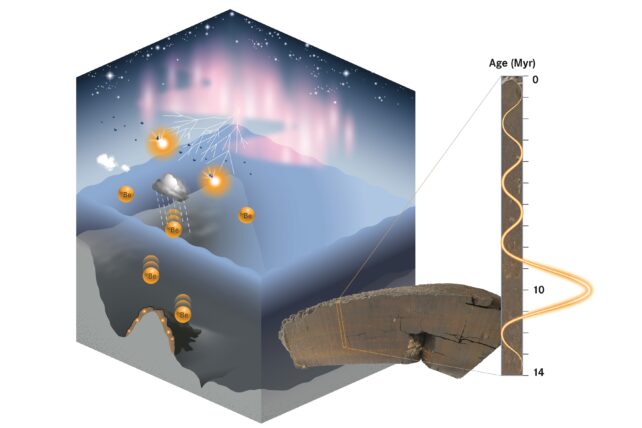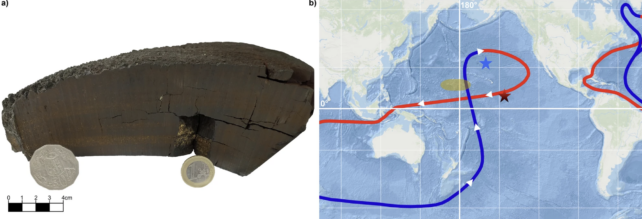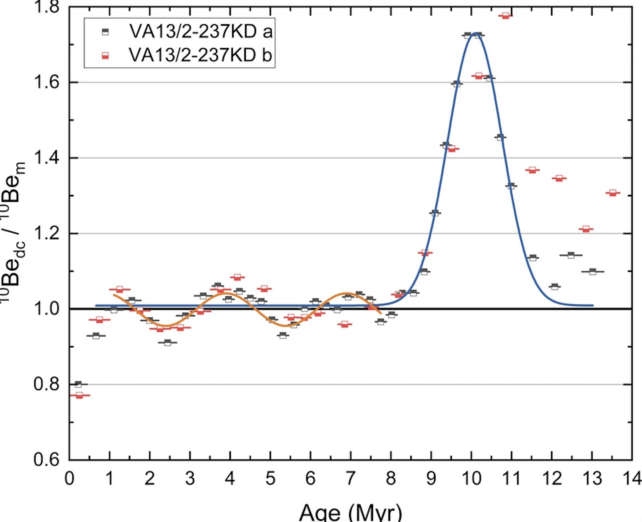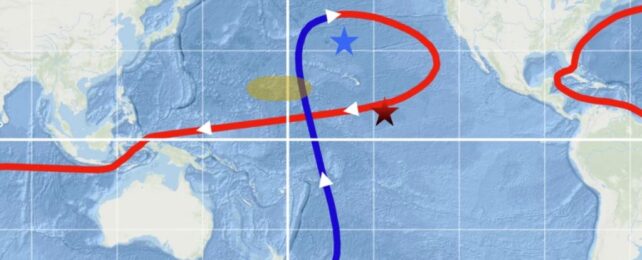A strange radioactive 'blip' has been detected deep beneath the Pacific Ocean.
Analyzing several thin layers of seafloor crust, scientists in Germany have identified a sudden surge in the radioactive isotope Beryllium-10 sometime between 9–12 million years ago.
The beryllium-10 blip was detected in the seabeds of the Central and the Northern Pacific, but the authors behind the study, led by physicist Dominik Koll of the Helmholtz-Zentrum Dresden-Rossendorf research institute, say the anomaly could be present throughout the Pacific, maybe even the world.
It's unknown where the sudden surge came from, but researchers have a few ideas.
Beryllium-10 is a radioactive isotope that is continuously produced by cosmic rays interacting with Earth's atmosphere. When it rains from the atmosphere and settles in the ocean, the isotope becomes incorporated into the extremely slow growth of some deep metal-rich crusts.
Maybe, more than 9 million years ago, there was "a grand reorganization" of the ocean currents that meant beryllium-10 was deposited more in the Pacific, suggest Koll and colleagues.
Or maybe this was a worldwide phenomenon. The cosmic fallout of a near-Earth supernova, or our Solar System's passage through a cold, interstellar cloud, could both result in more cosmic ray activity, the authors also hypothesize, leading to a surge in beryllium-10 deposits in the ocean.

Ferromanganese crusts that incorporate beryllium-10 exist in every ocean on Earth, and they can capture a million years of ocean chemistry in just a few millimeters.
Researchers can use the slow rate at which beryllium-10 radioactively decays into a form of boron as a measure of time, comparing the ratio of the two chemicals to determine the age of minerals in Earth's crust.
These thin, ancient crusts are near-continuous geological timelines of our planet's last 75 million years or so, but they are also very tricky to date with certainty. Carbon dating only goes back to about 50,000 years, and measures based on the decay of uranium isotopes aren't useful indicators, either.
Beryllium-10 is the key to unlocking at least 10 million years of this crusty capsule.
The half-life of beryllium-10 is about 1.4 million years, which means it is typically used to date up to 20 millimeters of ferromanganese crust. Most ferromanganese crusts are between 1 and 26 centimeters thick.

What Koll and his team found in the Pacific, however, was a surprise.
"At around 10 million years, we found almost twice as much 10Be as we had anticipated," explains Koll. "We had stumbled upon a previously undiscovered anomaly."
Like a bookmark in a tome, the team says this "anomaly has the potential to be an independent time marker for marine archives".
The team checked their work across several areas of the Pacific Ocean. One 50-millimeter slice of ferromanganese crust could be dated back more than 18 million years.
The growth rate of the ferromanganese crust in the Pacific was determined to be 1.52 mm per million years, which means the depth of the anomaly dates back to between 10.5 and 11.8 million years ago.
Wherever the beryllium-10 anomaly occurs in these samples essentially translates to that age.

"The origin of this anomaly is yet unknown," the authors write, but because our own Sun's activity probably wasn't strong enough to create such a long-lasting beryllium surge, the team suspects Earth's protection against interstellar cosmic rays may have changed roughly 10 million years ago.
Either that, or a really close supernova showered our planet with more radioactivity material than usual.
"Only new measurements can indicate whether the beryllium anomaly was caused by changes in ocean currents or has astrophysical reasons," says Koll.
"That is why we plan to analyze more samples in the future and hope that other research groups will do the same."
Only time will tell if the beryllium blip is a regional or global phenomenon.
The study was published in Nature Communications.
